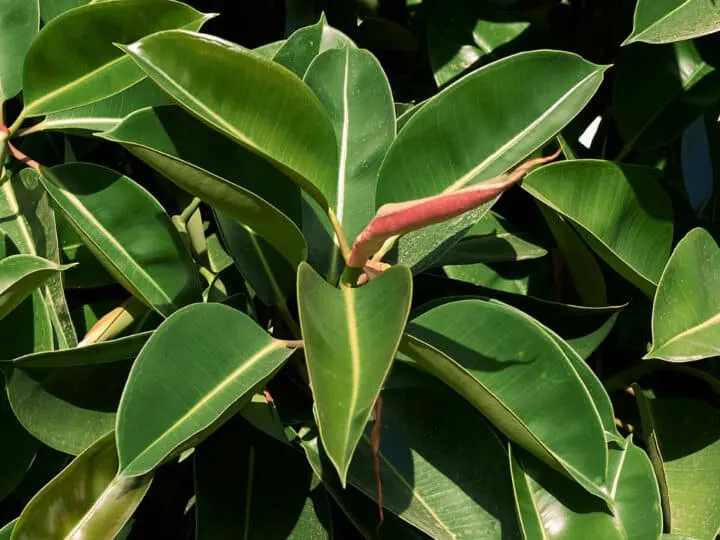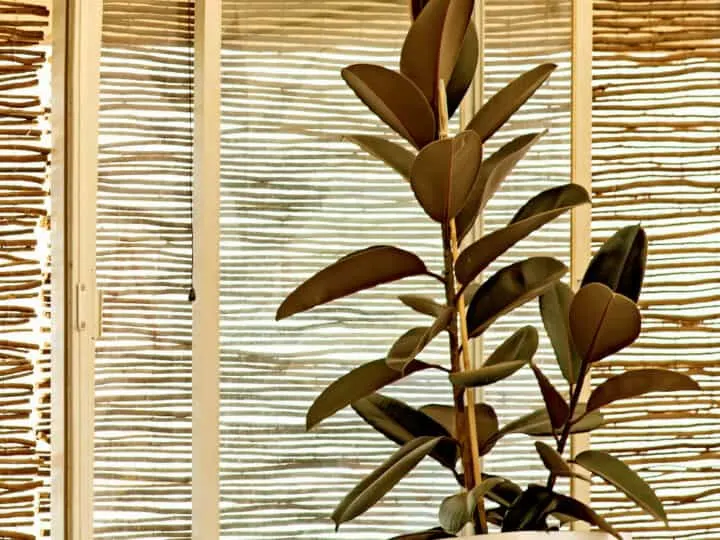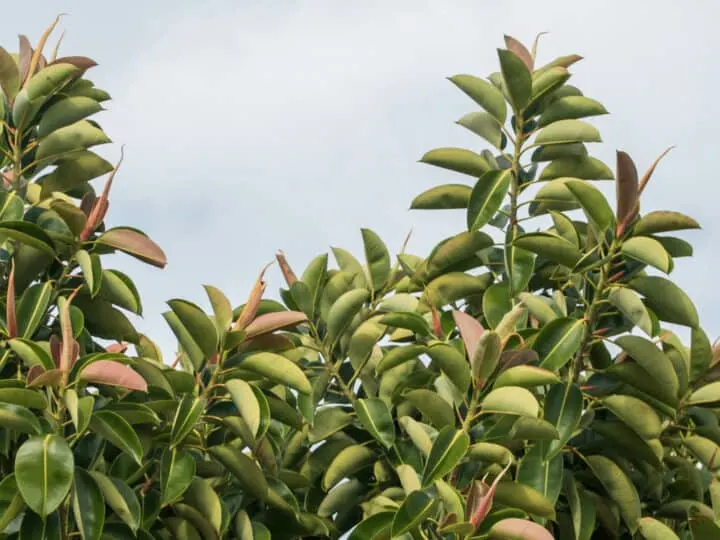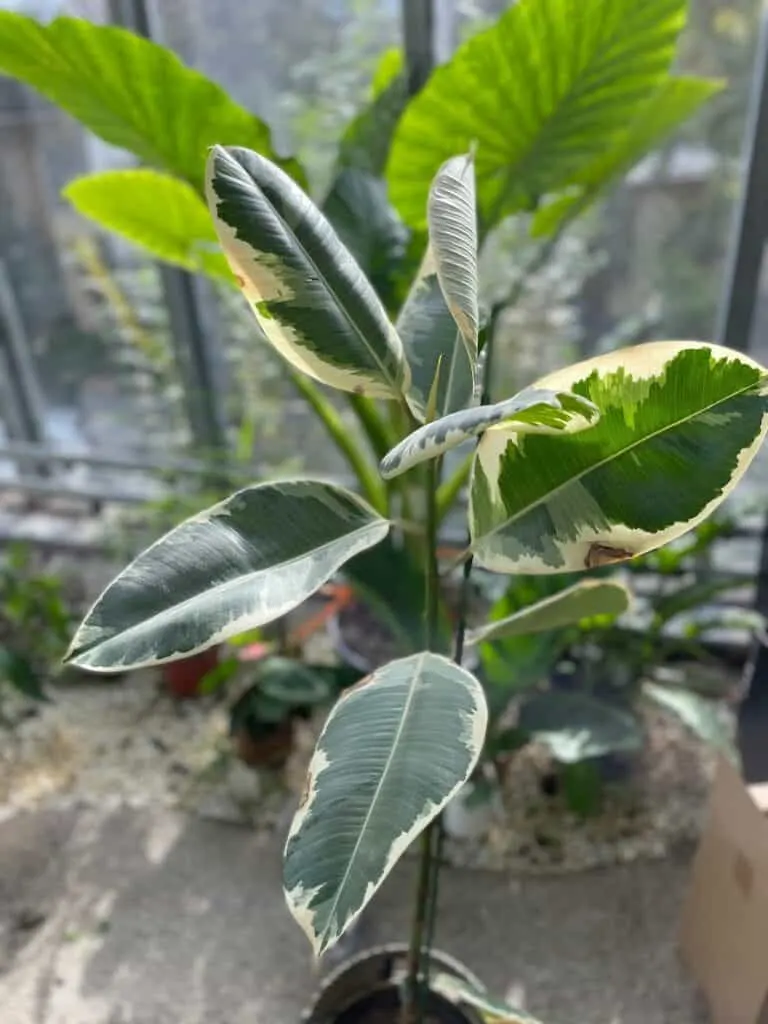In this article, you will learn the ins and outs of taking care of your own Rubber Plant (Ficus elastica). A popular ornamental houseplant, Ficus elastica is well-liked for its tree-like qualities.
Another common name, the rubber plant alludes to the leaves, which are large, glossy, simple, leathery, and feel like latex. Indoors, it can grow anywhere from 8 to 25 feet tall. Outdoors the rubber tree can grow up to 100 feet in height according to Missouri Botanical Garden (59m).
Table of Contents
Ficus Elastica Takeaways
| Species | Ficus elastica |
| Synonyms | Rubber fig,rubber bush,rubber tree,rubber plant,or Indian rubber bush,Indian rubber tree |
| Family | Moraceae |
| Genus | Ficus |
| Growth | Tree, shrub |
| Height | 100 feet |
| Width | 30 feet |
| Soil | Airy peat-based soil mix |
| Watering | Water every to 7 days |
| Light | Bright indirect |
| Temperature | 65 to 85°F |
| Humidity | 50-80% |
| Fertilizer | Fertilize 1 times per month |
| Propagation | Stem cuttings |
| Toxicity | Mildly toxic to humans and pets such as cats and dogs |
Rubber Plant Care
To care for Ficus elastica a well-draining peat-based potting mix and a temperature between 65 to 85°F (18-29°C) is optimal. Provide a humidity of 50% or more and fertilize every 2 months using a balanced liquid fertilizer with NPK 10-10-10 or 20-20-20. Water weekly in the growing season when the top 2-3 inches of soil (5-7.6cm) are dry.

Rubber Plant Growing Guide
In this section, I am going to cover the care of a rubber tree plant.
Soil
The best soil for a Ficus Elastica is a peat-based mix as it is airy and is able to drain exceptionally well.
These plants do like to be sitting in large amounts of water.
To set your Ficus elastica up for success, make sure that there is at least one working drainage hole located at the bottom of your pot.
Any water that is not needed by the plant will then be properly drained out instead of becoming waterlogged.
Light
Bright indirect sunlight is best for a Ficus Elastica.
Direct sunlight can scorch and harm the leaves.
3-4 hours of direct sunlight in the morning is fine, however.
This is what you get when placing a Ficus Elastica in an east-facing window.
This type of plant is found in different parts of the world such as India, China, Sri Lanka, Australia, and parts of the United States.
The habitats where you can find naturally existing Rubber trees have plenty of bright indirect sunlight, yet aren’t too warm.
When choosing a spot in your house, place the Rubber Plant where there is bright light without directly putting it in the range of rays.

Watering
Water a Ficus elastica once the top 2-3 inches of soil are dry (5-7.6cm) about once a week in spring and summer.
Before you think about watering your Ficus elastica, make sure to check the soil.
It should be partially dry.
It is important to understand that overwatering can cause harm to your Rubber Plant, especially during the non-growing season in winter and autumn.
In the summer, be careful to not let your Ficus elastica become too dry.
In the winter, Rubber plants become dormant, thus only needing water every once in a while.
Temperature
The optimal temperature range for a Ficus elastica is between 65 to 85 degrees Fahrenheit (18-29 degrees Celsius).
The Rubber Plant’s native habitat is tropical, meaning that the temperature can be quite warm.
Fortunately, this plant can survive in a wide range of temperatures as long as it does not drop below about 35 degrees Fahrenheit.
This is the average temperature found in a home, making it an easy need to meet.
Take note that this plant will not respond well to cold drafts or sudden changes in temperature.
Humidity
The ideal humidity level for a Ficus elastica is >=50%.
Your Ficus plant may not survive for long without the correct amount of humidity.
Recalling that they live in tropical regions, it isn’t hard to determine that they need a habitat with high humidity.
This requirement can be met by using a humidifier in more arid regions or homes with lower humidity below 50%.
Do not mist the leaves of your rubber tree as this can cause fungus to build up and it is not a great method to increase humidity. The humidity cannot be increased that way based on my personal observation and tests.

Fertilizer
Fertilize Ficus elastica using a balanced liquid fertilizer of NPK 10-10-10 or 20-20-20 every 2 months in spring and summer.
As mentioned earlier, this plant does go into a dormant phase during the colder months.
This is a defense mechanism.
You do not need to add fertilizer during this time of year.
Instead, you can focus any feeding your Rubber Plant during the spring and summer months.
The best regime would be to add fertilizer about every third or fourth month with a food high in micronutrients.
If you really want to keep the plant healthy, consider adding a half-teaspoon mixture of Epsom salts with a quart of water.
To correctly apply this fertilizer, soak the roots with your newly made concoction.

Propagation
You can propagate Ficus elastica using stem cuttings or through air layering (which also uses a part of the stem).
Air layering involves cutting the stems and soaking them with wet moss so that they will start developing new individuals.
This technique generally takes a few weeks in order to see results.
Growth
Ficus elastica can grow as high as 25 feet (7.6m).
In fact, this Ficus generally grows an extra 24 inches (60cm) per growing season in height.
As such, you should be prepared to provide the necessary propagation and pruning.
According to the University of Florida, Ficus elastica can grow up to 100 feet (30m) in nature.
The usual size however is 35-45 feet (10.5-13.7m).

Potting
Repot Ficus elastica every few years when the roots and leaves look crowded.
With the capability of growing upwards of 25 feet (7.6m) you may need to repot regularly.
This typically happens every few years, depending on how big the current living space is.
You will know that it is time to repot once the leaves and roots start to look crowded.
If, by any chance, the leaves of your Ficus plant start to shed, don’t panic.
You might not want to, but leaving it in its pot for a stable living space is best at that moment.
Rubber Plant Watering
By researching the right way to go about watering your new indoor tree, you will keep it alive and happy for years to come.
Follow this simple guide that discusses where, when, and how to water your Rubber Plant.
Where to water Ficus elastica
Before you continue on and begin watering your Ficus elastica, check the bottom of the pot. Are there proper drainage holes?
Watering your plant without these means that your Rubber Plant sits in water, increasing the chances of root rot.
Water your Ficus through a series of misting sessions when apprehensive about the amount of water you are using.
When to water Ficus elastica
You may look at your plant and assume that it needs water, but hold your horses.
Adding too much water to your Rubber Plant can actually do more harm than not watering enough.
To properly check if your indoor tree needs moisture, touch the topmost layer of soil, generally down to a few inches below the surface. If it is dry, then you may water it.
Ficus elastica tends to show clear signs when it is being overwatered.
If you see the yellowing of leaves, decrease the amount of water that you are adding.
Many plant owners either use their fingers to test the dryness of the soil, while others opt for a water meter.
Regardless of the way that you check, you should expect to add moisture once a week.
More Watering Tips
After reading that overwatering can cause rain roots, you might lessen the number of watering sessions you supply.
One tip is in regard to the drainage holes. If you have these, you can confidently drench the plant until you see water run out the bottom.
This actually allows your plant to get rid of any salt buildup from the fertilizer that you add.

Propagating The Rubber Plant
With how quickly the Rubber Plant grows, it is important to propagate.
You may not feel qualified, but it is actually quite easy. Some even say that it is therapeutic or fun.
There are two different types of propagation for a Rubber Plant (stem tip cutting & air layering), each of which is somewhat different in its level of difficulty.
More experienced houseplant owners usually complete a stem tip cutting as it can be challenging.
For those who are starting out with their indoor plants, air layering may be the way to go.
Propagate Through Stem Cuttings
To participate in this form of propagation, one needs to have the proper gardening scissors.
You then proceed to make an incision at the tip of the stem.
The cut must be made below the new growth buds so as to properly cultivate a new individual.
This new plant is then placed into a pot of its own until roots begin to form.
Propagation through Air Layering
The process of air layering can be explained as taking a part of the branch and wrapping it in a moistened medium.
This eventually starts the growth of new roots. This is among the easiest forms of propagation for the Rubber Plant.
To try it for yourself, follow these steps.
Step 1: The first step is to gather the correct materials such as a floral knife of some kind, a plastic bag, natural moss, twine, and a rag.
Step 2: Take the moss and place it in a bowl of water until it is thoroughly soaked. We recommend that you leave it submerged for about half an hour.
Step 3: Once your moss is ready, contemplate where you are going to make your cuts, typically far enough down on the stem.
Step 4: In the area where you have decided to make cuts, remove a few leaves. This is prepping the stem for what is about to happen.
Step 5: Now you may make the incision. Your cut should be horizontal to the plant at around ¼ inch underneath the top node.
Step 6: Make another cut about an inch below the first one, just in front of the bottom node. A trick of the trade is to make incisions that are deep enough to simply remove the outermost layer.
Step 7: With the outer layer removed, let it dry out completely.
Step 8: This step is somewhat optional. If you have a rooting hormone, add it now through cotton swabs.
Step 9: Finally take your wet moss and wrap it up into a ball. Place it completely around the area where you made a cut.
Step 10: Securely fasten the moss ball onto the cut sections so that the roots begin to grow. You can use your twine to make sure that the plastic is not going to budge.
After completing all ten of these steps, it is time to wait. Don’t remove the contained moss ball until a few weeks after you’ve started the process. This will give the roots ample time to grow into a new individual.
Rubber Tree Pests and Diseases
Learning the telling signs that your plant is unhappy or unhealthy in any fashion can save you from a dead plant later down the road.
Although this plant is easy to care for, you should still immerse yourself in the potential and common problems found in Rubber Plants. Hereby is a list of the most common rubber plant problems.
Problem: LEAVES THAT ARE DROOPING
If your plant starts to look a bit sad and droops quite a bit, you may consider the amount of water that you are exposing your Ficus plant to.
If your pot does not have at least a few drainage holes, transfer it to a pot that does.
Droopy leaves that have been this way for over a month or two may have root rot.
In order to save your plant from root rot, take the Ficus out of its pot and trim any section of the plant that is unhealthy.
Problem: SPOTS ON THE LEAVES
With plants, it is all too easy to find yourself providing too much water or simply underwatering.
If you start to notice small white dots on the tips of your Ficus plant’s leaves, check the moisture.
Although less of a concern, underwatering is still an issue in some houseplants.
Worried about adding too much water at first? Simply take a misting bottle to the top of the leaves.
Problem: WHITE DRIPS AND DRIED OUT LEAVES
Remember when we had spoken about propagating these tropical houseplants?
Well, chances are that you’ve come across tree sap when making these incisions. Even the smallest of cuts can yield a hefty amount of sap.
This then drips down until it lands on the leaves underneath.
The sap itself can be somewhat toxic to the human skin.
To help avoid this problem simply wet a moist towel and wipe it off.
Problem: LEAVES FALLING OFF
There are actually a few reasons why the leaves on your Ficus plant are falling off.
The most thought answer is when you provide too much or too little moisture.
Is there curling in the tips of the leaves followed by a slight yellowing?
If you see any of these signs, you may need to evaluate the amount of water being supplied to your Rubber Plant.
Another reason behind leaves falling out altogether is a sudden change in light or humidity.
Though not the pickiest plant, the Rubber Plant is notorious for doing poorly in drastic changes.
Problem: PESTS
The care for a rubber tree included dealing with plant pests such as thrips, spider mites, mealybugs, and aphids.
If you are seeing white, black, or red dots on your rubber tree leaves it is most likely pests and they need to be treated.
What works great is to use a damp cloth about once a week to get all the dust off the leaves. When using the cloth, inspect the leaf upper- and underside for pests.
Whenever you spot pests it is best to use mixtures of neem oil, rubbing alcohol, and dishwater soap. Dilute it in water and apply it using a spray bottle once a week.
Repeat the process for several weeks to get rid of pests as they may lay eggs into the soil and show up again after 2-3 weeks.
If nothing helps make use of a systemic insecticide. Follow the instruction on the package or leaflet.
Is Ficus elastica toxic?
Ficus elastica is mildly toxic to humans, cats, and dogs. When children ingest the plant it can lead to allergic reactions.
Frequently Asked Questions
How old does Ficus elastica get?
As with any living being, the longevity of a Ficus elastica can be affected by the quality of care that is provided. If you meet the entire necessary criterion, you may see your Ficus elastica plant living a total of 15 years, possibly even more.
How do you prune a potted Ficus elastica?
Once at the desired height, you may want to start pruning your Ficus elastica. Other than being for physical gain, pruning is a way to keep the plant happy and healthy. In order to prune your Rubber Plant, cut off the top of the Ficus followed by any branches that are not up to par. Pruning in the spring and summer months yields the best results.
How do you save a dying Ficus elastica?
Depending on the reason why your Ficus elastica t is struggling, you may be able to revive it. The first step is to identify the problem. If you have overwatered, save the individual by letting the soil dry. If it is not doing so, make sure to add drainage holes.
Is a Ficus elastica good for the home?
Other than looking good, the Rubber Plant is beneficial to you and your home. These easy-to-care-for household plants earn their keep by purifying the air that you breathe. Studies have shown that the air quality found indoors vastly improves if there is a special houseplant such as Ficus elastica.
Do Ficus elastica leaves grow back?
When it comes to the point that the leaf might be beyond repair, homeowners wonder if their plants will ever make it. The Rubber Plant only partially grows back what it loses. The lower parts of the plants do not regrow while the topmost levels will see new growth. Avoid losing leaves in the first place by giving your plant the right amount of water, light, fertilizer, and humidity.

Daniel has been a plant enthusiast for over 20 years. He owns hundreds of houseplants and prepares for the chili growing seasons yearly with great anticipation. His favorite plants are plant species in the Araceae family, such as Monstera, Philodendron, and Anthurium. He also loves gardening and is growing hot peppers, tomatoes, and many more vegetables.


